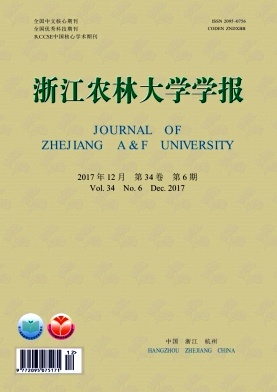-
桉树Eucalyptus原产澳大利亚,有945个种和变种,其木材广泛用于纸浆和人造板工业的原料[1],是中国华南地区重要造林树种之一,在木材供应、碳汇供给和生态环境改善等方面发挥着重要作用[2-3]。沿海的广东、广西、福建等省(区)既是中国人工林主产区[4],其人工林面积和蓄积量分别占全国的22.34%和24.62%[5],也是中国重要的桉树商品林生产基地[1]。沿海地区台风频发[6],已严重影响桉树及其产业的发展[7],亟须选择抗风树种(品系)用于商品林的建设[1, 8]。赤桉Eucalyptus camaldulensis是桉属中一个较为广泛栽培的树种[9],国内主要分布在华南以及云南等区域。赤桉为优质的硬木材,因其耐高温、干旱,稍耐碱的特性,为干热河谷地区解决山地植被恢复的理想树种,赤桉不但耐旱、耐瘠,而且抗风抗病能力强,为中国桉树树种改良的重要遗传材料[10]。已有的赤桉研究主要集中在木材干燥处理[11-12]、遗传基因[13-15]等方面。国内已广泛开展桉树抗风性树种/无性系的选择研究,但大多集中在生长性状水平上[6, 16-17],赤桉由于其独特的抗风特性备受关注,已进行了初步的抗台风研究[18]。本研究以50个3~4年生赤桉家系为材料,研究其林木生长性状、纤维性状及材性性状与抗风性能之间的相关性,以及获得影响赤桉抗风的主要因子,为进一步选育优良抗台风桉树品系奠定基础。
HTML
-
试验林设在南方国家级林木种苗示范基地(简称种苗基地)内,位于广东省湛江市遂溪县岭北镇附近,21°30′N,111°38′E,为热带北缘季风气候,平均遭受10级以上台风袭击2~3次·a-1,台风最大风力大于35 m·s-1[1]。本研究实验材料为2012年8月造林的114个赤桉家系。试验设计为完全随机区组,设置4个区组重复,4株·小区-1,株行距2 m × 3 m,面积约为1.43 hm2。
-
于2015年12月,选取3年生赤桉20个较抗风家系和30个弱抗风家系进行树高、胸径调查,4个重复,对存活家系进行每木检尺,树高利用VtrtexⅣ(瑞典Haglof)超声波测高测距仪测定,胸径利用胸径尺测定。单株材积(V)采用广西林业勘查设计院总结的广西速生桉单株材积计算公式[19]:$ V = {C_0} \times {D^{\left[{{C_1}-{C_2} \times \left( {D + H} \right)} \right]}} \times {H^{\left[{{C_3} + {C_4}\left( {D \times + H} \right)} \right]}} $。其中:V为单株材积;D为地径;H为树高;C0=0.000 109 154 150;C1=1.878 923 70;C2=0.005 691 855 03;C3=0.652 598 05;C4=0.007 847 535 07。
-
对试验林中1~3重复区内的各家系存活单株进行木芯的采集,利用林木生长锥(瑞典Haglof,内径4.3 mm)在每个单株南北方向1.3 m处进行木芯采集,置入标好编号的纸皮信封中,做好标记后带回实验室进行材性相关性状测定。参照GB /T 1933-2009《木材密度测定方法》测定各家系的木材基本密度[20]。采用加拿大LDA 02全自动纤维质量分析仪(fiber quality analyzer)对其纤维形态特征长度、宽度、长宽比测定。
-
Pilodyn是一种间接测定木材密度的无损检测仪器。Pilodyn测定仪可有效地对立木材性(如强度和密度)间接评估[21]。采用瑞典Pilodyn(6J-Forest)仪器(探针直径为2.5 mm)在立木胸径(高1.3 m)处测定,获得立木密度和强度相关的去皮Pilody值(Pilodyn penetration value)。木材中应力波的传播速度与木材的物理、力学性能直接相关,因此通过测量应力波的传播时间或传播速度可确定木材材质的性能[22]。应力波值以匈牙利Fakopp 2D测定仪(Fakopp microsecond timer)测定高0.2~1.7 m立木段应力波的传播时间,重复5次,取平均值。
-
以1522号强台风“彩虹”(2015年10月4日登陆广东湛江坡头区,中心最大风力为50 m·s-1,15级,为1949年以来10月份登陆广东的最强台风[23])对赤桉试验林的风害进行单株林木抗风性评价,台风风害指数参照王睿等[24]划分为6级:0级,主干没有明显倾斜;1级,主干倾斜与垂直距离小于30°;2级,主干倾斜与垂直夹角为30°~60°;3级,主干倾斜与垂直夹角60°~90°;4级,树干倒伏或连根拔起;5级,树干折断。
-
所有数据均值、标准差、F值、P值以SPSS软件分析,变异系数、相关系数用Genstat 7.0软件(VSN,英国)分析。分别就赤桉家系的生长性状、纤维性状及风害级等指标以Excel(XP)软件进行数据收集整理,以Genstat 7.0软件分别就赤桉家系生长性状、纤维性状及风害指数等指标以BLUP((best linear unbiased prediction,BLUP)进行建模分析,获得家系遗传方差和环境方差,并分析计算各性状遗传变异系数、环境变异系数、理论表型变异系数、家系遗传力以及各性状间的遗传相关系数等,再进行家系评选。
式(1)~式(4)中:S为表型标准差,δg2为遗传方差,δe2为环境方差,δp2为表型方差,x为某一性状的平均值。
遗传力估算公式:
式(5)和式(6)中:hf2为家系遗传力,hs2为单株遗传力,δf2为家系方差,δfb2为家系与区组交互方差,δe2为机误方差,b为调和区组数,n为调和小区均数,r为授粉系数(r取0.3)。
参照黄少伟等[24]方法进行遗传相关分析,采用如下公式计算:
式(7)~式(9)中:Covp12为2个性状的表型协方差;$ {\delta _{{{\rm{p}}^1}}^2} $,$ {\delta _{{{\rm{p}}^2}}^2} $分别为2个性状的表型方差;Covg12为2个性状的遗传协方差;$ {\delta _{{{\rm{g}}^1}}^2} $,$ {\delta _{{{\rm{g}}^2}}^2} $分别为2个性状的遗传方差;Cove12为2个性状的环境协方差;$ {\delta _{{{\rm{e}}^1}}^2} $,$ {\delta _{{{\rm{e}}^2}}^2} $分别为2个性状的环境方差。利用多性状进行主成分法进行家系的评选。
式(10)中:h2为遗传力,S为表型标准差,x为某一性状群体平均值。
1.1. 试验林及材料
1.2. 研究方法
1.2.1. 赤桉家系树高和胸径的测定
1.2.2. 木芯样品采集及木材性状的测定
1.2.3. Pilodyn值和应力波值的测定
1.2.4. 风害指数的测定
1.2.5. 数据统计与分析
-
50个赤桉家系生长性状均值及变幅见表 1。树高平均值为9.86 m,最大为17.90 m,胸径平均值为10.12 cm,最大值为17.30 cm,单株材积平均值为46.96×10-3 m3,最大为165.60×10-3 m3。树皮厚度平均值为0.59 cm,最大为1.62 cm。方差分析结果(表 2)显示:各家系间树高差异性呈极显著水平(P<0.01),胸径、树皮厚度差异性不显著(P=0.062,P=0.174),单株材积间差异性达到显著水平(P<0.05)。
性状 树高/m 胸径/cm 单株材积/ (×10-3 m3) 树皮厚度/cm 纤维长度/mm 纤维宽度/μm 纤维长宽比 木材基本密度/(g·cm-3) Pilodyn值/mm 应力波值/μs 风害指数/级 平均值 9.86 10.12 46.96 0.59 0.578 25.43 22.78 0.45 13 489.79 1.85 变幅 1.30~ 17.90 3.20~ 17.30 1.90~ 165.60 0.22~1.62 0.478~ 0.704 21.30~ 30.10 18.33~ 27.95 0.17~0.65 1.5~ 17.8 322.60~ 655.40 1.00~5.00 标准差 3.46 2.82 29.51 0.18 0.039 1.30 1.54 0.04 1.8 48.52 1.62 自由度 326 325 325 323 323 322 323 326 325 312 321 Table 1. Mean value and standard deviation of 50 Eucalyptus camaldulensis family
性状 自由度 均方差 F P 树高 46 3.763 2.52 < 0.001 胸径 46 10.209 1.38 0.062 单株材积 46 1 240.5 1.54 0.020 树皮厚度 46 0.037 63 1.22 0.174 纤维长度 46 0.002 904 2.32 < 0.001 纤维宽度 46 4.159 3.37 < 0.001 纤维长宽比 46 7.98 0.91 0.636 木材基本密度 46 0.004 473 3.08 < 0.001 Pilodyn值 46 5.287 1.79 0.002 应力波值 44 7 424.04 5.05 < 0.001 风害指数 45 4.863 2.19 < 0.001 Table 2. Variance analysis of different traits among 50 E. camaldulensis families
变异系数是衡量各性状指标观测值变异程度。遗传变异系数可反映遗传因素导致性状观测值相对变异程度,遗传变异系数大小可反映家系在该性状中可利用的改良潜力大小[25]。生长性状(树高、胸径、单株材积、树皮厚度)中变异系数最大为62.84%(表 3),变异系数最小的为胸径(27.87%)。遗传力可以体现性状的稳定程度,其值越大则性状越稳定,受环境作用小,选择的效果越好[26],从表 3遗传力分析可以看出:树高家系遗传力小于单株遗传力,胸径、材积、树皮厚度性状家系遗传力大于单株遗传力。单株遗传力为0.046~0.644,家系遗传力变幅为0.077~0.590。胸径、材积、树皮厚度性状的单株遗传力和家系遗传力均较低(hf2<0.5),不宜在早代作出选择。树高遗传力较高,说明树高不易受环境条件的影响,上下代之间可遗传性强,对育种材料取舍在早期世代进行选择也可取得比较好的效果。从遗传变异系数看,以单株材积(16.59%)最大,其次是树高(15.26%);环境变异系数最大的是材积(60.71%),理论表型变异系数和通过家系单株的变异系数之间差异很小,说明通过BLUP模型计算出的遗传变异系数、环境变异系数、理论表型变异系数值可靠。进一步说明各家系性状间存在着丰富的遗传变异。
性状 家系方差δf2 机误方差δe2 单株遗传力hs2 家系遗传力hf2 变异系数VC/% 遗传变异系数/% 环境变异系数VEC/% 理论表型变异系数VPC/% 树高 2.279 0 9.516 0 0.644 0.590 35.09 15.26 31.19 34.73 胸径 0.234 0 7.567 0 0.100 0.157 27.87 4.78 27.18 27.59 单株材积 60.700 0 813.000 0 0.232 0.309 62.84 16.59 60.71 62.94 树皮厚度 0.000 4 0.031 5 0.046 0.077 30.51 3.56 30.09 30.30 纤维长度 0.241 2 1.253 6 0.539 0.536 6.75 2.70 6.15 6.72 纤维宽度 0.458 0 1.268 0 0.885 0.684 5.11 2.66 4.43 5.17 纤维长宽比 0.165 4 2.123 5 0.243 0.320 6.76 1.78 6.36 6.61 木材基本密度 0.000 4 0.001 5 0.771 0.643 9.56 4.72 8.62 9.83 Pilodyn值 0.364 0 2.952 0 0.366 0.425 14.15 4.64 13.21 14.01 应力波值 860.00 1 481.00 0.825 0.777 9.91 5.99 7.86 9.88 风害指数 0.409 0 2.231 0 0.516 0.524 87.57 34.57 80.74 87.83 Table 3. Variation coefficients and genetic parameters of different traits of E. camaldulensis family
-
由表 1可见:在纤维形态性状上,家系的纤维长度平均值为0.578 mm,变幅为0.478~0.704 mm;纤维宽度平均值为25.43 μm,变幅为21.3~30.1 μm;纤维长宽比平均值为22.78。赤桉家系的木材基本密度最大值为0.653 g·cm-3,最小值为0.171 g·cm-3,平均值为0.450 g·cm-3。木材无损指标Pilodyn值、应力波值的平均值分别为13.00 mm,489.79 μs。赤桉各家系的风害指数均大于0级,风害指数范围1~5级,平均风害指数为1.85级,表明整个林分所有立木均遭受不同程度的风害。方差分析(表 2)显示:纤维长度、纤维宽度、木材基本密度、Pilodyn值、应力波值差异极显著(P<0.01),纤维长宽比差异不显著(P=0.636)。表明赤桉家系间纤维形态、材性指标、风害指数存在显著差异,可进一步筛选生长较快、材性较好的抗风品系。
对50个赤桉家系在不同材质性状和风害指数进行单株遗传力、家系遗传力、遗传变异系数、环境变异系数、表型变异系数计算,结果如表 3。纤维长度和风害指数2个指标的家系遗传力和单株遗传力值非常接近,纤维宽度、木材基本密度及应力波值的家系遗传力小于单株遗传力,纤维长宽比和Pilodyn值家系遗传力大于单株遗传力。单株遗传力值为0.243~0.885,家系遗传力变幅为0.320~0.777,纤维长宽比、Pilodyn值的单株和家系遗传力值均较低(hf2<0.50)。纤维宽度、木材基本密度、应力波单株遗传力较高,分别为0.885,0.771,0.825,而其家系遗传力也比较高,分别为0.684,0.643,0.777,表明这些性状受环境条件的影响小,上下代之间可遗传性强,可在早期世代进行选择。从遗传变异系数看,以风害指数最大(34.57%),纤维长宽比最小(1.78%),纤维宽度(2.66%)和纤维长度(2.70%)也较小;环境变异系数最大的也是风害指数(80.74%),变异较小的是纤维长度(6.15%)和纤维长宽比(4.43%),纤维宽度最小(4.43%);理论表型变异系数与变异系数基本一致,以风害指数(87.83%)最大,纤维宽度最小(5.17%)。以上说明各性状之间存在丰富的遗传变异,使进一步选择优良抗风家系成为可能。
-
从表 4可以看出:赤桉纤维长度与材性(木材基本密度、Pilodyn值和应力波值)均呈极显著性相关,纤维宽度与生长性状(树高、胸径、单株材积)也呈极显著相关关系。Pilodyn值、应力波值与木材基本密度指标之间均呈0.01水平上的显著相关性。风害指数与树高、单株材积、树皮厚度、应力波值的Pierson相关系数达到0.05水平上的显著。进一步根据各家系各性状的BLUP模型进行遗传相关分析,获得如表 5各性状与风害指数之间的遗传相关、环境相关、表型相关结果。
性状 纤维长度 纤维宽度 纤维长宽比 树高 胸径 单株材积 树皮厚度 木材基本密度 Pilodyn值 应力波值 纤维宽度 0.377** 纤维长宽比 0.702** -0.392** 树高 -0.049 -0.253** 0.140* 胸径 -0.080 -0.323** 0.168** 0.484** 单株材积 -0.096 -0.304** 0.137* 0.782** 0.861** 树皮厚度 -0.081 -0.224** 0.089 0.376** 0.671** 0.620** 木材基本密度 0.234** 0.075 0.175** 0.036 0.047 0.006 0.075 Pilodyn值 -0.169** -0.093 -0.093 -0.041 0.020 -0.015 -0.029 -0.386** 应力波值 -0.514** -0.356** -0.244** 0.020 -0.017 0.046 0.077 -0.418** 0.343** 风害指数 0.066 0.109 -0.012 -0.607** -0.078 -0.346** -0.120* 0.045 0.059 -0.123* 说明:*表示0.05水平相关显著;**表示0.01水平相关显著。 Table 4. Correlation coefficients among different traits of Eucalyptus camaldulensis family
性状 遗传相关 表型相关 环境相关 树高 -0.939** -0.617** -0.551** 胸径 -0.390** -0.111* -0.093 单株材积 -0.924** -0.342** -0.277** 树皮厚度 -0.799** -0.150* -0.124 纤维长度 -0.062 0.124* 0.159 纤维宽度 0.382** 0.128* 0.064 纤维长宽比 -0.114 -0.039 -0.0468 木材基本密度 0.021 0.043 0.048 Pilodyn值 -0.531** 0.051 0.139* 应力波值 -0.304** -0.449** 0.137* 说明:*表示0.05水平相关显著;**表示0.01水平相关显著。 Table 5. The genetic, phenotypic, environmental relevance between wind damage index and growth, wood traits
从表 5可知:赤桉生长性状(树高、胸径、材积、树皮厚度等)与风害指数在遗传相关上呈极显著负相关;在表型相关上,树高、单株材积与风害指数达到极显著负相关,胸径和树皮厚度与风害指数呈显著负相关;环境相关上,树高和单株材积与风害指数呈极显著负相关,胸径和树皮厚度与风害指数不相关。由此可见:风害指数与赤桉生长性状具有极大的关系,尤其是树高和单株材积极显著影响赤桉的抗风性能,所以树高越高,材积越大,赤桉抗风能力越强。赤桉材性性状中,风害指数与木材纤维长度、纤维长宽比无论是遗传、表型以及环境的相关性不强,而与纤维宽度在遗传、表型的相关性均达0.01水平上的显著,其遗传相关系数为0.382;风害指数与Pilodyn值、应力波值的遗传相关性强,均呈显著负相关,但与Pilodyn值的表型相关性不明显,而风害指数与木材基本密度在3种相关系数中均不显著。Pilodyn值、应力波值与抗风指数存在显著环境正相关,表明立木赤桉抗风性能与材性性状纤维宽度、Pilodyn值、应力波值密切相关。
综上所述,树高、单株材积与抗风性能的相关关系在遗传、环境及表型上均高于其他性状,进一步说明树高和单株材积在很大程度上影响赤桉立木的抗风性。这些结果为优良抗风赤桉品系间接选择提供了依据,培育长势好又抗风的优良赤桉新品系是可能的。
-
对50个家系进行主成分分析,取前4个主成分PC1~PC4,其中,PC1与各生长性状为正向效应,PC2与纤维、材性性状呈正向效应,PC3与纤维性状呈正向效应,PC4与抗风性能呈负相关效应,因此根据育种目标选择PC1,PC2,PC3值大而PC4值小的家系,即可获得长势较好而风害较低的优良抗风家系。又由于所研究个体为3~4年生赤桉家系,因此将成活率作为重要影响因子考虑在内,先将PC1,PC2,PC3,PC4进行等权重计算得分后再与成活率等权重重新计算得分并各家系的秩次排名。以10%的入选率对50个赤桉家系进行评价选择,获得家系2007,2006,20027,2005,2008等5个家系(表 6)。家系的性状及遗传增益见表 7。入选的5个家系各性状遗传增益范围为0.53~22.93,其中抗风性能(风害指数负值)最大,为22.93,其次为树高(14.47)。其中单株材积的平均值为49.29×10-3 m3,高于总平均值4.96%,增益为0.53;风害指数的平均值为1.27级,低于总平均值1.85级的31.35%,遗传增益为22.93。
家系 PCI PC2 PC3 PC4 成活率/% 2007 0.046 0.828 -0.603 0.157 0.980 2006 -0.111 0.129 -0.468 0.711 0.980 20027 0.878 0.878 -1.026 -1.089 0.980 2005 0.067 0.755 -0.409 0.012 0.980 2008 -0.096 0.114 -0.492 -0.010 0.920 Table 6. The top 5 families of Eucalyptus camaldulensis of principal component indices and survival rate
项目 纤维长度/cm 纤维宽度/μm 纤维长宽比 树高/m 胸径/ cm 单株材积/ (×10-3m3) 树皮厚度/cm 木材基本密度/(g·cm-3) Pilodyn值/mm 应力波值/μs 风害指数/级 优树平均值 0.570 25.18 22.67 10.95 10.17 49.29 0.61 0.448 13.12 511.57 1.27 总平均值 0.578 25.43 22.78 9.86 10.12 46.96 0.59 0.447 13.0 489.79 1.85 差值率/% -1.38 -0.98 -0.48 11.05 0.49 4.96 3.39 0.22 0.92 4.45 -31.35 遗传增益 3.16 2.42 1.83 14.47 3.54 0.53 1.82 4.86 4.97 7.14 -22.93 Table 7. Comparison of average traits and genetic gain of fine families selected from 50 families
2.1. 不同家系主要生长性状的变异和遗传分析
2.2. 不同家系材质性状和风害指数的变异和遗传分析
2.3. 风害指数与生长和材质性状的相关性分析
2.4. 赤桉抗风家系的综合评价
-
不同赤桉家系的生长及材性性状对抗风性的影响方差分析发现:除胸径、树皮厚度2个性状外,生长、材性、风害指数等其余9个性状在家系水平上差异显著,表明不同赤桉家系的生长和材性性状不同,抗风能力不同,这与已有的研究结果一致[27]。变异系数和遗传分析表明,参试家系各性状的变异系数较高,表明赤桉具有丰富的遗传变异,遗传改良潜力较大,使得选择生长与抗风性状优良的家系成为可能。遗传力分析表明单株和家系的纤维宽度、应力波值、木材基本密度、树高以及其风害指数等性状均具有中等以上的遗传力。
相关性分析可以体现各性状之间的关系,了解性状间的相关程度, 有利于林木育种改良和提高效率。Pierson相关分析表明:赤桉林木的风害指数主要与树高、单株材积、树皮厚度、应力波值显著相关,与沿海防护林木麻黄Casuarina equisetifolia,相思Acacia spp.抗风性能的结果一致[7]。进一步从遗传相关、环境相关、表型相关出发研究各性状基因型、环境因素分别对赤桉抗风性能的影响。赤桉所有生长性状及材性性状中,纤维宽度、Pilodyn值、应力波值与抗风性能均存在极显著遗传相关性,树高、单株材积与赤桉风害指数存在极显著表型、环境负相关,纤维宽度、应力波值与风害指数存在显著表型相关,Pilodyn值、应力波值与风害指数存在显著环境相关。表明赤桉生长性状中树高、材积与单株立木风害程度密切相关,其次是胸径和树皮厚度;材性性状中,应力波值与立木抗风性能有关,其次是纤维宽度和Pilodyn,这与Pierson相关性分析结果一致[28]。罗建中等[1]在桉树杂交种生长与抗风的遗传变异研究中发现尾叶桉Eucalyptus urophylla子代的树高、胸径均和抗风能力呈正显著相关。本研究发现:在遗传、环境及表型上,树高、单株材积与抗风性能的相关系数均高于其他性状系数,说明林木抗风性是可以遗传的,树高和单株材积在很大程度上影响赤桉抗风性,表明林木大小是影响其抗风性的主要因子,其次是材性因子,这与PHILIPPE等[28]认为树干大小是决定抗风/风害的重要影响因子之一的结论相符。
遗传增益是评价林木育种效果的重要参数,可以用来表明育成群体超出现有群体的多少来体现育种的成效。本研究利用主成分评价后和成活率进行等权重计算得分,对50个赤桉家系排名,最终选出5个抗风优良赤桉家系2007,2006,20027,2005和2008。入选的家系抗风能力较强,树高改良效果较好,各性状的平均值均比总平均值有所增加。由于桉树是短周期轮伐树种,本研究采用的3~4年生赤桉生长性状、木材性状与风害指数进行联合分析,经15级强台风风害检测,其结果极具有代表性,因此,本研究筛选出的5个生长较快又抗风的家系可应用于生产实际。









 DownLoad:
DownLoad: